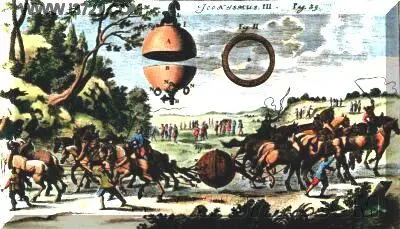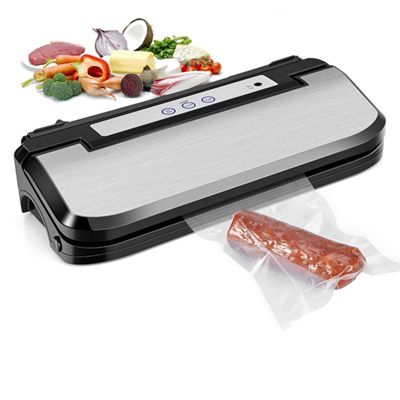An Introduction to Vacuum Packaging for Food
Every time when i go to the supermarket, i seem to suffer from an occupational disease. I really want to eat those food that is vacuum-packed, such as marinated eggs, dried tofu, chicken legs, beef meat balls, etc. Vacuum packaging technology can be seen everywhere in shopping malls and supermarkets, but it is rarely used in our daily life. Today we will talk about this food preservation technology that should be used more.
 1. The history of the vacuum
1. The history of the vacuum
In 1643, the Italian physicist Torricelli proved the existence of a vacuum. A vacuum has attracted a lot of attention since its birth, but it only serves as a supporting role to prove the existence of atmospheric pressure, for example, the famous hemisphere experiment in Magdeburg. In 1654, the mayor of Magdeburg combined the two copper hemispheres and then vacuumed them. He directed 16 horses to make the two copper hemispheres apart in public just to prove the existence of atmospheric pressure.
About 3 centuries later, it was not until the 1940s that vacuum packaging technology was born. Vacuum packaging machines developed rapidly after the successful application of polyester and polyethylene plastic films to commodity packaging in 1950.
Nowadays, there are all kinds of plastic vacuum packaging. Plastic vacuum packaging featured in lightweights, seals, freshness, deterioration resistance and antirust are widely used in food, medicine, knitwear, precision product manufacturing, metal processing plants, laboratories and many other fields.
With the increase in vacuum applications, there are more and more materials used for vacuum packaging. In addition to plastics, there are other materials such as aluminum foil, glassware, plastic composite, etc.
2. Vacuum plus 0℃ prolonging the freshness many times
In vacuum science, vacuum refers to a gas state that is below atmospheric pressure in given space, and the vacuum state is a thin gas state. Even in outer space, it is not completely vacuum; it is just nearly vacuum. Of course, vacuum packaging can't achieve the effect of a complete vacuum, but the vacuum sealing without air and oxygenation is already a good storage environment for food.
Experiments show that when the oxygen concentration in the vacuum bag is less than or equal to 1%, the growth and reproduction speed of microorganisms will drop sharply. When the oxygen concentration is less than or equal to 0.5%, most microorganisms will be inhibited and stop reproducing. Vacuum packaging by removing the air and oxygen can inhibit bacteria and prevent food from mildewing. In addition, there are plenty of unsaturated fatty acids for food containing oil and fat. If they are oxidized, they will change color, taste, go bad as well as lose vitamin A and C. Removing air and oxygen can effectively maintain the color, flavour and nutritional value of food.
 However, vacuum packaging cannot inhibit the growth of anaerobic bacteria and the deterioration and discoloration of food caused by reactions with enzyme. Other auxiliary methods need to be combined with the vacuum packaging, such as refrigeration, quick freezing, dehydration, high temperature sterilization, irradiation sterilization, microwave sterilization and salting. Among them, freezing is the easiest to operate. Any perishable food that needs to be refrigerated, such as beef meat balls, fresh fish, etc. They still need to be refrigerated or frozen after vacuum packaging. Vacuum plus 0℃ is the correct way to extend the preservation period for food, which can easily extend the food preservation time by 3 to 5 times.
However, vacuum packaging cannot inhibit the growth of anaerobic bacteria and the deterioration and discoloration of food caused by reactions with enzyme. Other auxiliary methods need to be combined with the vacuum packaging, such as refrigeration, quick freezing, dehydration, high temperature sterilization, irradiation sterilization, microwave sterilization and salting. Among them, freezing is the easiest to operate. Any perishable food that needs to be refrigerated, such as beef meat balls, fresh fish, etc. They still need to be refrigerated or frozen after vacuum packaging. Vacuum plus 0℃ is the correct way to extend the preservation period for food, which can easily extend the food preservation time by 3 to 5 times.
Dry food, miscellaneous grains, medicinal materials, etc., can be placed at room temperature after vacuum packaging by a vacuum sealer. Vacuum packaging isolates bacteria in the air, and can solve the problems of moisture, rot, bacteria and one flavour being tainted by other flavour. There is no need to worry about snacks being affected by moisture, rot of meat, deterioration of seafood, moldy tea, one flavour being tainted by other flavour, etc.
 1. The history of the vacuum
1. The history of the vacuumIn 1643, the Italian physicist Torricelli proved the existence of a vacuum. A vacuum has attracted a lot of attention since its birth, but it only serves as a supporting role to prove the existence of atmospheric pressure, for example, the famous hemisphere experiment in Magdeburg. In 1654, the mayor of Magdeburg combined the two copper hemispheres and then vacuumed them. He directed 16 horses to make the two copper hemispheres apart in public just to prove the existence of atmospheric pressure.
About 3 centuries later, it was not until the 1940s that vacuum packaging technology was born. Vacuum packaging machines developed rapidly after the successful application of polyester and polyethylene plastic films to commodity packaging in 1950.
Nowadays, there are all kinds of plastic vacuum packaging. Plastic vacuum packaging featured in lightweights, seals, freshness, deterioration resistance and antirust are widely used in food, medicine, knitwear, precision product manufacturing, metal processing plants, laboratories and many other fields.
With the increase in vacuum applications, there are more and more materials used for vacuum packaging. In addition to plastics, there are other materials such as aluminum foil, glassware, plastic composite, etc.
2. Vacuum plus 0℃ prolonging the freshness many times
In vacuum science, vacuum refers to a gas state that is below atmospheric pressure in given space, and the vacuum state is a thin gas state. Even in outer space, it is not completely vacuum; it is just nearly vacuum. Of course, vacuum packaging can't achieve the effect of a complete vacuum, but the vacuum sealing without air and oxygenation is already a good storage environment for food.
Experiments show that when the oxygen concentration in the vacuum bag is less than or equal to 1%, the growth and reproduction speed of microorganisms will drop sharply. When the oxygen concentration is less than or equal to 0.5%, most microorganisms will be inhibited and stop reproducing. Vacuum packaging by removing the air and oxygen can inhibit bacteria and prevent food from mildewing. In addition, there are plenty of unsaturated fatty acids for food containing oil and fat. If they are oxidized, they will change color, taste, go bad as well as lose vitamin A and C. Removing air and oxygen can effectively maintain the color, flavour and nutritional value of food.
 However, vacuum packaging cannot inhibit the growth of anaerobic bacteria and the deterioration and discoloration of food caused by reactions with enzyme. Other auxiliary methods need to be combined with the vacuum packaging, such as refrigeration, quick freezing, dehydration, high temperature sterilization, irradiation sterilization, microwave sterilization and salting. Among them, freezing is the easiest to operate. Any perishable food that needs to be refrigerated, such as beef meat balls, fresh fish, etc. They still need to be refrigerated or frozen after vacuum packaging. Vacuum plus 0℃ is the correct way to extend the preservation period for food, which can easily extend the food preservation time by 3 to 5 times.
However, vacuum packaging cannot inhibit the growth of anaerobic bacteria and the deterioration and discoloration of food caused by reactions with enzyme. Other auxiliary methods need to be combined with the vacuum packaging, such as refrigeration, quick freezing, dehydration, high temperature sterilization, irradiation sterilization, microwave sterilization and salting. Among them, freezing is the easiest to operate. Any perishable food that needs to be refrigerated, such as beef meat balls, fresh fish, etc. They still need to be refrigerated or frozen after vacuum packaging. Vacuum plus 0℃ is the correct way to extend the preservation period for food, which can easily extend the food preservation time by 3 to 5 times.Dry food, miscellaneous grains, medicinal materials, etc., can be placed at room temperature after vacuum packaging by a vacuum sealer. Vacuum packaging isolates bacteria in the air, and can solve the problems of moisture, rot, bacteria and one flavour being tainted by other flavour. There is no need to worry about snacks being affected by moisture, rot of meat, deterioration of seafood, moldy tea, one flavour being tainted by other flavour, etc.
Next: Vacuum Packaged Food Doesn't Mean No Spoilage
Previous: How to Store White Tea?
